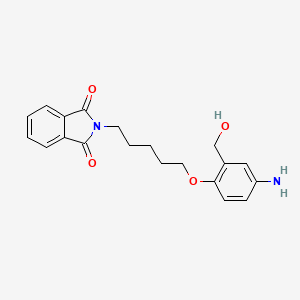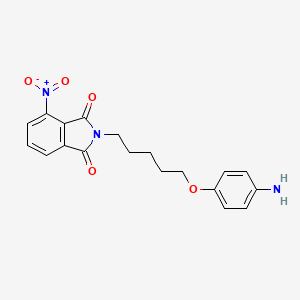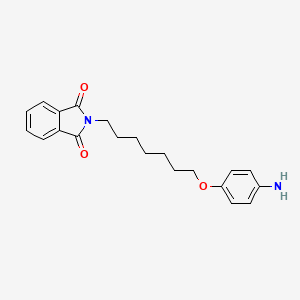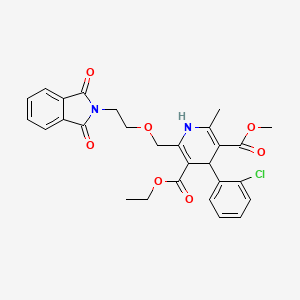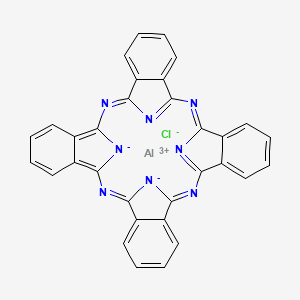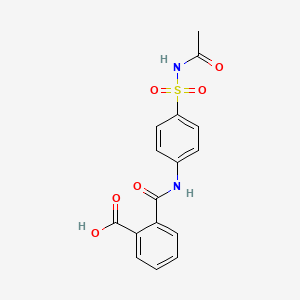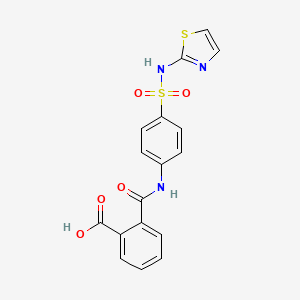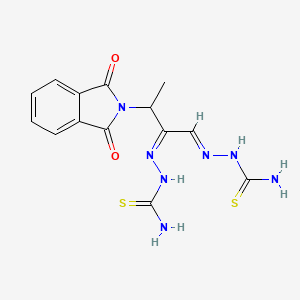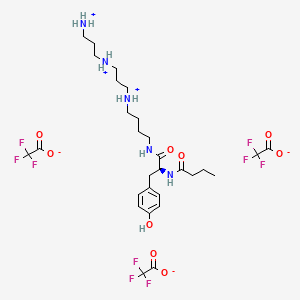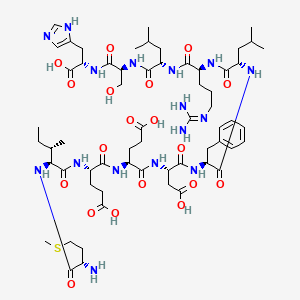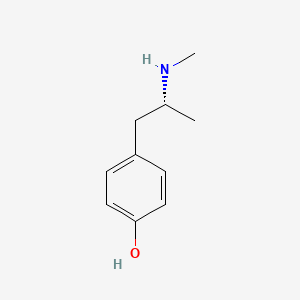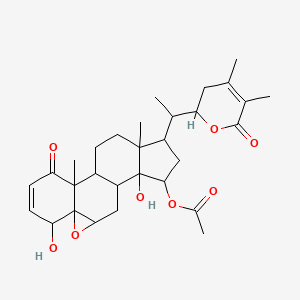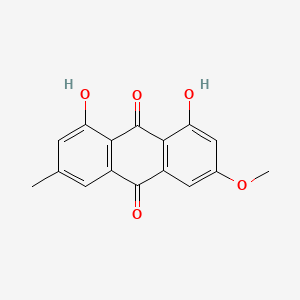
オキサリプラチン
概要
説明
オキサリプラチンは、主に大腸がんの治療に使用される白金系抗がん剤です。白金含有抗悪性腫瘍剤のクラスに属し、DNAと架橋を形成してDNAの複製と転写を阻害する能力で知られています。 この化合物は、大腸がん、卵巣がん、膵臓がんを含むさまざまな種類のがんの治療に有効性が示されています .
2. 製法
合成経路と反応条件: オキサリプラチンは、白金化合物と特定のリガンドを反応させる多段階プロセスによって合成されます。主要な合成経路には、シス-ジヨード(トランス-1,2-ジアミノシクロヘキサン)白金(II)とシュウ酸の反応が含まれます。 反応条件には通常、目的の生成物を形成するために制御された温度とpHが含まれます .
工業生産方法: 工業環境では、オキサリプラチンは、反応条件が厳密に制御された大規模反応器を使用して生産されます。これにより、高い収率と純度が達成されます。 プロセスには、高純度の出発物質と溶媒を使用することが含まれ、最終製品は、その有効性と安全性を確保するために厳格な品質管理対策を受けます .
3. 化学反応の分析
反応の種類: オキサリプラチンは、置換、酸化、還元など、いくつかのタイプの化学反応を起こします。 最も注目すべき反応は、DNAと共有結合を形成する能力であり、これは鎖内および鎖間架橋の形成につながります .
一般的な試薬と条件: オキサリプラチンを含む反応では、塩化物イオン、水、さまざまな有機溶媒などの特定の試薬を必要とする場合があります。 条件には通常、目的の化学変換を促進するために制御された温度とpHレベルが含まれます .
生成される主な生成物: オキサリプラチンの反応から生成される主な生成物はDNA付加体であり、これはその細胞毒性効果の原因となります。 これらの付加体はDNAの複製と転写を阻害し、細胞死につながります .
4. 科学研究への応用
オキサリプラチンは、特に化学、生物学、医学、産業の分野において、科学研究で幅広い用途があります。
化学: 化学において、オキサリプラチンは、白金系薬物がDNAやその他の生体分子と相互作用する様式を研究するためのモデル化合物として使用されます。 研究者は、その反応性と結合特性を調査して、新しくより効果的な白金系薬物を開発しています .
生物学: 生物学的研究では、オキサリプラチンは、がん細胞における薬物耐性のメカニズムを研究するために使用されます。 科学者は、がん細胞が白金系薬物に対する耐性をどのように発達させるかを調査し、この耐性を克服する方法を探しています .
医学: 医学において、オキサリプラチンは大腸がんの治療における基盤となっています。FOLFOXなどのレジメンでは、フルオロウラシルやロイコボリンなどの他の化学療法薬と組み合わせて使用されることが多いです。 臨床試験では、他の種類のがんの治療における有効性も引き続き調査されています .
産業: 製薬業界では、オキサリプラチンは臨床使用のための注射液として生産され、製剤化されています。 その生産には、患者の安全と有効性を確保するために厳格な品質管理対策が含まれています .
科学的研究の応用
Oxaliplatin has a wide range of applications in scientific research, particularly in the fields of chemistry, biology, medicine, and industry.
Chemistry: In chemistry, oxaliplatin is used as a model compound to study the interactions of platinum-based drugs with DNA and other biomolecules. Researchers investigate its reactivity and binding properties to develop new and more effective platinum-based drugs .
Biology: In biological research, oxaliplatin is used to study the mechanisms of drug resistance in cancer cells. Scientists explore how cancer cells develop resistance to platinum-based drugs and seek ways to overcome this resistance .
Medicine: In medicine, oxaliplatin is a cornerstone in the treatment of colorectal cancer. It is often used in combination with other chemotherapeutic agents such as fluorouracil and leucovorin in regimens like FOLFOX. Clinical trials continue to explore its efficacy in treating other types of cancer .
Industry: In the pharmaceutical industry, oxaliplatin is produced and formulated into injectable solutions for clinical use. Its production involves stringent quality control measures to ensure its safety and efficacy for patients .
作用機序
オキサリプラチンは、DNAと共有結合を形成してDNA架橋を形成することによって効果を発揮します。これらの架橋はDNAの複製と転写を阻害し、最終的に細胞死を引き起こします。 オキサリプラチンの主要な分子標的はDNAのプリン塩基であり、そこで鎖内および鎖間架橋を形成します .
オキサリプラチンの作用機序に関与する経路には、DNA損傷応答経路の活性化があり、細胞周期停止とアポトーシスにつながります。 この化合物はまた、がん細胞の修復メカニズムを妨害し、それらを細胞毒性効果の影響を受けやすくなります .
6. 類似化合物の比較
オキサリプラチンは、シスプラチンやカルボプラチンなどの他の白金系抗がん剤と比較されることが多いです。3つの化合物はすべて同様の作用機序を共有していますが、オキサリプラチンはそれを他のものとは異なる独自の特性を持っています。
類似化合物:
オキサリプラチンの独自性: オキサリプラチンは、より安定したDNA付加体を形成する能力が独特であり、がん細胞の細胞毒性を高めます。 また、副作用のパターンも異なり、腎毒性と耳毒性の発生率は低いですが、末梢神経障害の発生率は高くなります .
結論として、オキサリプラチンは、科学研究と臨床診療において幅広い用途を持つ重要な化学療法薬です。その独特の特性と作用機序により、がんとの闘いにおいて貴重なツールとなっています。
生化学分析
Biochemical Properties
Oxaliplatin interacts with various enzymes, proteins, and other biomolecules. Its mechanism of action primarily involves DNA damage through DNA crosslinking, particularly intrastrand and interstrand crosslinking . The structure of oxaliplatin allows its adducts to bind mismatch repair proteins to DNA more difficultly compared to cisplatin or carboplatin’s adducts, resulting in greater cytotoxic effects .
Cellular Effects
Oxaliplatin has a cytotoxic effect in a broad range of cell lines, including colon, ovarian, and lung cancer . It damages the DNA of cells and stops it from being copied. This stops or slows the growth of cancer cells and other rapidly growing cells and causes them to die .
Molecular Mechanism
The molecular mechanism of Oxaliplatin involves the formation of platinum-DNA adducts. The retention of the bulky DACH ring by activated oxaliplatin results in the formation of these adducts, which appear to be more effective at blocking DNA replication and are more cytotoxic than adducts formed from cisplatin .
Temporal Effects in Laboratory Settings
The pharmacokinetics of unbound platinum in plasma ultrafiltrate after oxaliplatin administration is triphasic, characterized by a short initial distribution phase and a long terminal elimination phase . No accumulation was observed in plasma ultrafiltrate after 130 mg/m^2 every 3 weeks or 85 mg/m^2 every 2 weeks .
Dosage Effects in Animal Models
In animal models, the effects of Oxaliplatin vary with different dosages. For example, in mice, PKM2 silencing induced resistance in HT29 and SW480 cells and sensitivity in HCT116 cells . The highest recommended dose of oxaliplatin in patients is 110 mg/m^2 (2.97 mg/kg) .
Metabolic Pathways
Oxaliplatin is involved in various metabolic pathways. Accumulated doses of oxaliplatin led to significant changes in gene expression related to energy-related metabolic pathways including fatty acid oxidation, amino acid metabolism, glycolysis, electron transport chain, and NAD synthesis pathway .
Transport and Distribution
Oxaliplatin is transported and distributed within cells and tissues. The copper transporter 1 seems to be of particular importance for cisplatin uptake in tumor cells, while the organic cation transporter (OCT) 2, due to its specific organ distribution, may play a major role in the development of undesired cisplatin side effects .
Subcellular Localization
Oxaliplatin undergoes nuclear translocation in response to oxaliplatin in HCT116 and HT29 cells but not in OXA-resistant HTOXAR3 cells . This suggests that the subcellular localization of Oxaliplatin may play a role in its effectiveness and resistance.
準備方法
Synthetic Routes and Reaction Conditions: Oxaliplatin is synthesized through a multi-step process involving the reaction of platinum compounds with specific ligands. The primary synthetic route involves the reaction of cis-diiodo(trans-1,2-diaminocyclohexane)platinum(II) with oxalic acid. The reaction conditions typically include a controlled temperature and pH to ensure the formation of the desired product .
Industrial Production Methods: In industrial settings, oxaliplatin is produced using large-scale reactors where the reaction conditions are meticulously controlled to achieve high yields and purity. The process involves the use of high-purity starting materials and solvents, and the final product is subjected to rigorous quality control measures to ensure its efficacy and safety .
化学反応の分析
Types of Reactions: Oxaliplatin undergoes several types of chemical reactions, including substitution, oxidation, and reduction. The most notable reaction is its ability to form covalent bonds with DNA, leading to the formation of intrastrand and interstrand cross-links .
Common Reagents and Conditions: The reactions involving oxaliplatin often require specific reagents such as chloride ions, water, and various organic solvents. The conditions typically include controlled temperatures and pH levels to facilitate the desired chemical transformations .
Major Products Formed: The primary products formed from the reactions of oxaliplatin are DNA adducts, which are responsible for its cytotoxic effects. These adducts prevent DNA replication and transcription, leading to cell death .
類似化合物との比較
Cisplatin: Known for its efficacy in treating testicular, ovarian, and bladder cancers. .
Carboplatin: Used in the treatment of ovarian and lung cancers. .
Uniqueness of Oxaliplatin: Oxaliplatin is unique in its ability to form more stable DNA adducts, leading to greater cytotoxicity in cancer cells. It also has a different side effect profile, with a lower incidence of nephrotoxicity and ototoxicity but a higher incidence of peripheral neuropathy .
特性
| Oxaliplatin undergoes nonenzymatic conversion in physiologic solutions to active derivatives via displacement of the labile oxalate ligand. Several transient reactive species are formed, including monoaquo and diaquo DACH platinum, which covalently bind with macromolecules. Both inter and intrastrand Pt-DNA crosslinks are formed. Crosslinks are formed between the N7 positions of two adjacent guanines (GG), adjacent adenine-guanines (AG), and guanines separated by an intervening nucleotide (GNG). These crosslinks inhibit DNA replication and transcription. Cytotoxicity is cell-cycle nonspecific. | |
CAS番号 |
61825-94-3 |
分子式 |
C8H14N2O4Pt |
分子量 |
397.29 g/mol |
IUPAC名 |
[(1R,2R)-2-azanidylcyclohexyl]azanide;oxalic acid;platinum(2+) |
InChI |
InChI=1S/C6H12N2.C2H2O4.Pt/c7-5-3-1-2-4-6(5)8;3-1(4)2(5)6;/h5-8H,1-4H2;(H,3,4)(H,5,6);/q-2;;+2/t5-,6-;;/m1../s1 |
InChIキー |
DRMCATBEKSVAPL-BNTLRKBRSA-N |
SMILES |
C1CCC(C(C1)[NH-])[NH-].C(=O)(C(=O)[O-])[O-].[Pt+4] |
異性体SMILES |
C1CC[C@H]([C@@H](C1)[NH-])[NH-].C(=O)(C(=O)O)O.[Pt+2] |
正規SMILES |
C1CCC(C(C1)[NH-])[NH-].C(=O)(C(=O)O)O.[Pt+2] |
外観 |
white solid powder |
沸点 |
100ºC |
| 63121-00-6 61825-94-3 |
|
物理的記述 |
Solid |
ピクトグラム |
Irritant; Health Hazard |
純度 |
>98% (or refer to the Certificate of Analysis) |
関連するCAS |
63121-00-6 63121-00-6 (SP-4-2 (trans)) |
賞味期限 |
>10 years if stored properly |
溶解性 |
Soluble in water at 4 mg/mL and DMSO at 20 mg/mL; slightly soluble in methanol; insoluble in ethanol. |
保存方法 |
Dry, dark and at 0 - 4 C for short term (days to weeks) or -20 C for long term (months to years). |
同義語 |
1,2 Diaminocyclohexane Platinum Oxalate 1,2-diaminocyclohexane platinum oxalate 1,2-diamminocyclohexane(trans-1)oxolatoplatinum(II) ACT 078 ACT-078 ACT078 cis-oxalato-(trans-l)-1,2-diaminocyclohexane-platinum(II) Eloxatin Eloxatine L-OHP cpd oxalato-(1,2-cyclohexanediamine)platinum II oxaliplatin oxaliplatin, (SP-4-2-(1R-trans))-isomer oxaliplatin, (SP-4-2-(1S-trans))-isomer oxaliplatin, (SP-4-3-(cis))-isomer oxaliplatine Platinum(2+) ethanedioate (1R,2R)-1,2-cyclohexanediamine (1:1:1) platinum(II)-1,2-cyclohexanediamine oxalate |
製品の起源 |
United States |
Retrosynthesis Analysis
AI-Powered Synthesis Planning: Our tool employs the Template_relevance Pistachio, Template_relevance Bkms_metabolic, Template_relevance Pistachio_ringbreaker, Template_relevance Reaxys, Template_relevance Reaxys_biocatalysis model, leveraging a vast database of chemical reactions to predict feasible synthetic routes.
One-Step Synthesis Focus: Specifically designed for one-step synthesis, it provides concise and direct routes for your target compounds, streamlining the synthesis process.
Accurate Predictions: Utilizing the extensive PISTACHIO, BKMS_METABOLIC, PISTACHIO_RINGBREAKER, REAXYS, REAXYS_BIOCATALYSIS database, our tool offers high-accuracy predictions, reflecting the latest in chemical research and data.
Strategy Settings
| Precursor scoring | Relevance Heuristic |
|---|---|
| Min. plausibility | 0.01 |
| Model | Template_relevance |
| Template Set | Pistachio/Bkms_metabolic/Pistachio_ringbreaker/Reaxys/Reaxys_biocatalysis |
| Top-N result to add to graph | 6 |
Feasible Synthetic Routes
試験管内研究製品の免責事項と情報
BenchChemで提示されるすべての記事および製品情報は、情報提供を目的としています。BenchChemで購入可能な製品は、生体外研究のために特別に設計されています。生体外研究は、ラテン語の "in glass" に由来し、生物体の外で行われる実験を指します。これらの製品は医薬品または薬として分類されておらず、FDAから任何の医療状態、病気、または疾患の予防、治療、または治癒のために承認されていません。これらの製品を人間または動物に体内に導入する形態は、法律により厳格に禁止されています。これらのガイドラインに従うことは、研究と実験において法的および倫理的な基準の遵守を確実にするために重要です。


